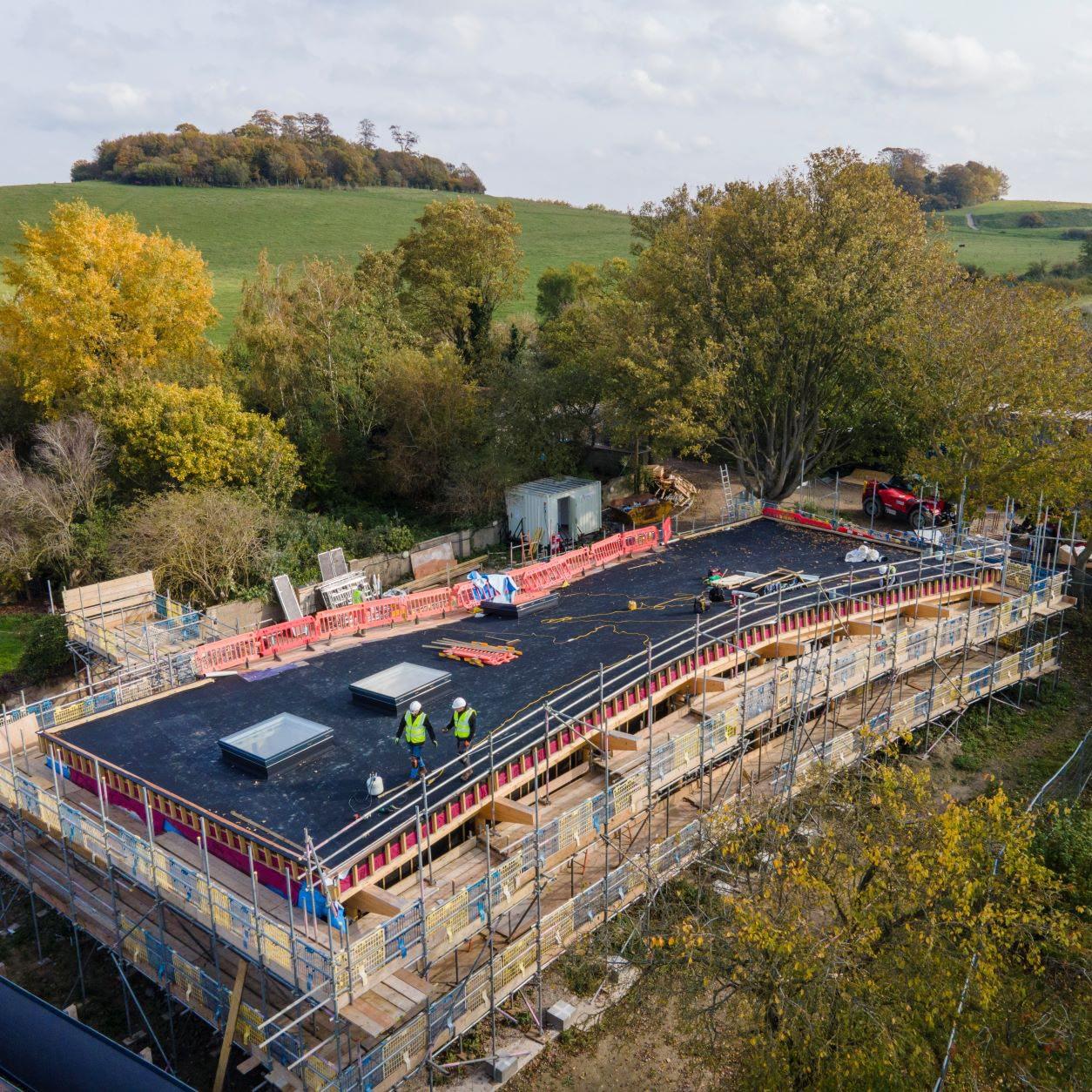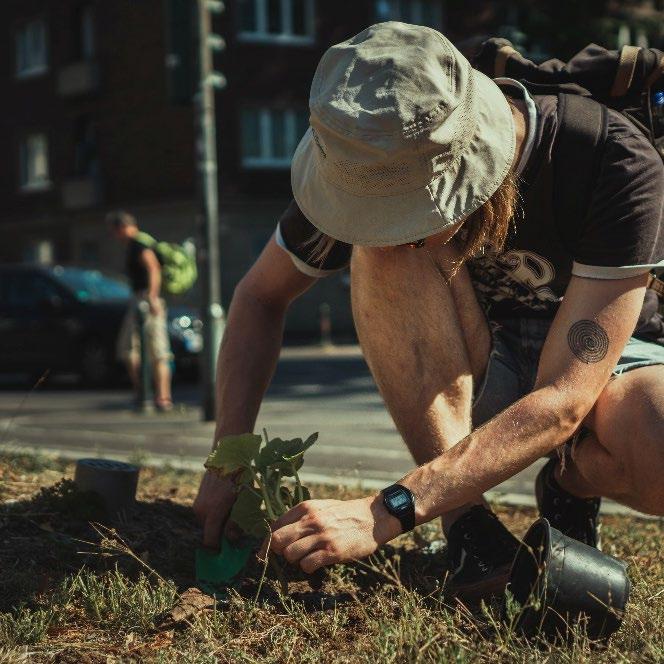
9 minute read
Time for action
Putting people, wildlife and climate at the heart of development requires a more creative and collaborative approach to how natural capital and the built environment integrate. To be successful, it has to be a co-creation between the public, private and third sectors.
Our panel, Jane Houghton, Julia Thrift Pete Massini, Rachel Stancliffe, Ben Gardner and Geeta Ludhra discuss.
Advertisement
What do you feel needs to be done to encourage more and better partnerships that can achieve some of the goals we've talked about here?
GL We need to look at the power and the privilege that different partners hold - break up the jigsaw and put it back together by looking at the different areas of the community that are included. Because unless we have representatives, reflective of all people of society we are not going to have genuine partnerships.
JH Within the Green Infrastructure Framework we start with partnership and joint visioning. The new concept of the nature recovery network is being led by local nature partnerships based within different counties. Within those nature partnerships we try to engage a broad range of people across sectors from business to health, the environment, young people and so on to ensure that those partnerships have wide representation and that society is reflected in their decision-making, and their points of view.
PM Partnership has become a rather hackneyed phrase, that I think we use too glibly to describe a whole range of coalitions and collaborations with many different purposes. A partnership to get a building constructed is very different from one that’s about bringing communities together to determine what they want and need. Sometimes a very tightly defined partnership with a particular purpose in mind is perfectly fine but if it's about coming up with a vision or a strategy or a proposition you need to bring together a much wider range of viewpoints and stakeholders to have that discussion – that’s about dialogue and open conversation to reach a vision rather than “partnership” with a specific purpose. As a former a policymaker I know that the language of policy often avoids being too prescriptive, but we need to be careful not to become obfuscatory.
How important is it for all these issues to be built into the planning process?
BG The government has obviously done a lot to introduce initiatives like biodiversity offsetting/biodiversity net gain, habitat banking. But, while local authorities and others in the planning system are being told to do this, they are not being told how. So it's hugely important that they work in partnership with experts to understand and decide how to get the greatest benefit for biodiversity as they possibly can.
JT : Planning is inherently political - it's about how we use the scarce resources in the country, how we use our land and who gets what. So people, quite rightly, will have something to say about it. We sometimes see delays in planning caused by public objection as a fault in the system, but perhaps that's planning working as it should - allowing people to voice their opinions, allowing discussion? It's always going to be a compromise. As Geeta mentioned, looking at who has the power is hugely important. Planning is complicated and it can be difficult for communities to engage with in an informed way where they can bring their experience and their knowledge. It requires a bit of support and it takes time, which is necessary if it means that more people get their say. If we're really going to put the environment at the heart of planning that means doing things differently – and there will be some crunchy, difficult bits where things don’t happen as they’ve always done. But perhaps we should see that as a sign of progress? If it's just business as usual we'll carry on creating the same problems as we've had for the last 30 or 40 years.
JH: A really key principle is to engage in a strategic way around planning for places right at the start of the conversation. That includes the concept of the right development in the right space and place - part of which will mean considering the green infrastructure standards. By having that really early conversation, these tensions can be ironed out in a win-win way so that planning isn’t overturned when a massive amount of work has already gone into it. In Natural England we're starting to really focus all our energy at the outset of those conversations because we feel that's the place where we can have most influence and we can get the right decisions made then that will then flow out to the development further down the line.
Audience questions to the panel
How do we get house builders and developers to fully commit to green infrastructure and/or delivering low carbon homes?
JT: The housing market isn't like other markets - if you want to buy a car you can look at a magazine or a website that will tell you “this car is good for that” and “this car is quite good for this” and you'll choose your car based on how it aligns with your preferences. With housing, buyers (or renters) need a home in a particular place, and they need one they can afford. With affordability being such a critical factor, there aren't the usual pressures to improve and evolve with consumer preferences because people desperate for homes will buy what’s provided whether they like it or don't like it very much. I think the only way to raise standards to get the high quality green infrastructure that we need is mandate them. If standards become required as part of national planning policy, builders will factor delivering those standards into the price of land. If it's optional, it will happen in some places - probably the wealthier places with the higher land values - but it won't happen in the poorer places with the lower land values, where people tend to have the worst health.
While no-one would argue with the need to support greater biodiversity, health and climate outcomes, who is going to pay for the changes we need to make, given the high price of land? There is a risk that we push up the cost of houses at a time when we need many hundreds of thousands of new homes at affordable prices.
BG: For years, we’ve been following process that has had some successes but largely has failed in terms of biodiversity. There's been a huge decline in species numbers and diversity so we can't just carry on doing what we've always done. The biodiversity net gain agenda gives us an opportunity to go beyond the protection of individual sites or individual species on sites, and apply this strategically. If we look nature recovery areas in Oxfordshire for example, the funds will largely come from BNG and developers but without the risk of losing lots of housing units on your site. Developers will be able to build biodiversity into their sites andmay be able to build more units than anticipated by offsetting negative impacts in places with the most benefit for biodiversity
RS: This argument that change will cost more has been one that we have had to counter in the healthcare sector for a long time. For years we have made the argument – and demonstrated – that change doesn’t have to cost more - economies of scale can help to lower supply chain costs, for example. And then there is the bigger question about whether are actually counting the real cost to begin with: we want the outcomes of health and healthy places but we're not costing the inputs properly. If we do, then prices will change and the price of places without green space built in will actually cost more because of the health impacts on the people that live there and the damage that is being done to the environment. There are potentially some useful lessons from the health sector – while policy mandates are in discussion, we can still do a lot to educate/inform people who are making decisions on the ground.
PM: I think government policy around BNG is trying to deliver an overly simple solution to a really complex problem. BNG doesn't really take into account that development is a complex trade-off between land prices, land value, and meeting existing objectives and policy requirements. When government introduced the idea of BNG there was an assumption that we had loads of cheap land available to deliver offsetting in areas requiring nature recovery. But, most viable land is in private ownership, and the value of agricultural land is going up because of the crisis in Ukraine. There will be a market in that land and not all offsetting will go into the areas where people expect it to go because developers will quite rightly choose options that are most beneficial to them. So it's likely to be a bumpy ride for the next couple of years as this policy actually lands in the real world, and as developers and landowners understand the relationship between the requirement of BNG and the market that the government intends to develop for offsetting.
We’ve talked about vision in the sense of the right place and the right scheme, do you think people are listening and if they're not listening how can that process be improved?
GL: Sometimes, we have agendas for listening and if things don't match our agendas we can quite easily switch off. We need people in positions of power who are able to hear - sometimes you can't hear because you don't know what you're supposed to be hearing.
My story of healing intergenerational trauma as a brown woman through nature is very different to my white counterparts for example. So we need people in positions who know these stories and are equipped to listen.
We've talked a lot about the benefits of access and connectivity to nature , but, not everybody sees those benefits. Among those who are most effected by the cost of living crisis ,there are parents who can’t let their children go and enjoy muddy play because they can't afford to run a wash. Or, they are worried about the safety of their children in the local park. We need to work with local communities - as Geeta says - to understand these stories and understand how the different interactions with nature and how we can support work at a neighbourhood scale. We’ve talked a lot about big developments - that's really importantbut it's in our existing communities where the largest health inequalities exist and we've got to make those a priority.
‘Outfall safaris’ where it takes people out into their local neighbourhood and really encourages them to look at what is there. They take people to a river and point out all the outfalls are to help them understand that the water you use in your house, or when you wash your car on your drive ends up in the river. They also do a basic asset audit of your local community –point out bits of green space and asking people to think “what are they for? Who owns it, how is it maintained and why?” Coming here today, I drove past acres of green spaces, road verges and roundabouts which are mown every two weeks – we need to ask - why do we do that?
Are there examples of quick wins – at a local level –that we could replicate to help move this agenda forward?
PM: There are a couple of examples that spring to mind for me from working in London. Thames21 runs

Closing words
Jane Norris, Director of Edgars shares her key takeaways from the panel discussion.
This moment is an opportunity to make a change. Public awareness of the value of access to nature has massively increased. Covid shifted our reality, and made many of us think about what's important to us. In addition, recent legislative changes signal increased political will - the environment act, and requirement for biodiversity gain, the levelling up and regeneration bill all bring new opportunities for consultation and comment on what's coming from the government. There is new emphasis on the environment within design codes and the national planning policy framework that needs to be integrated – and interrogated – within planning application consultations. Everything that's built from now on without a zero carbon or biodiversity agenda being taken into account is a retrofit problem.

Oxfordshire is an area where innovation and doing things differently is absolutely at the forefront. We have a significant regional track record in collaboration and problem solving, and I am confident that we can make great progress together in the challenge to build nature in.
But to do this, requires a number of things. Something I had not expected to take away from this event, was the need for humility: to recognize that we don't understand everything and everybody has a different perspective. Humility enables us to listen more, hear the perspective of other people and take on board what they can bring to the table.
So, stay humble, make representations when there's an opportunity at national planning policy level and keep collaborating. It doesn't matter if the conversation is difficult - the conversation has to keep going because we are at a critical point. Let’s use our collective talent and knowledge to create something better for everybody.
Let’s work together
We are seeking opportunities to bring together partners and collaborators who share our vision and can help us apply our 6 Building Nature In principles to create new learning and evidence.
Please do get in touch if you would like to discuss ideas.






